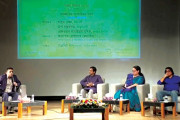Grammar-translation method teaches students to analyze grammar and to translate from one language to another. This method restricts language learning to a very narrow that does not prepare students to use the language in everyday life.
।। Masum Billah ।।
Integrating the four language skills such as listening, speaking, reading and writing enhances the focus on realistic communication, which is essential in developing stu¬dents’ competence in English. It exposes English language learners to authentic language and challenges them to interact naturally in the language. Learners rapidly gain a true picture of the richness and complexity of the English language as employed for communication. This approach stresses that English is not just an object of academic interest nor merely a key to passing an examination; instead, English becomes a real means of interaction. This strand also includes associated or related skills such as knowledge of vocabulary, spelling, pronunciation, syntax, meaning, and usage. Communicative competence and the ability to use English to gain access to social, vocational, educational, or professional opportunities has been the most essential objectives of English learning due to the use of English as the major lingua franca and the main medium disseminating information and knowledge worldwide. To achieve the goal in EFL contexts, implementing integrated language skills instruction seems to be the best option. Different from the traditional segregated language skills approach which presented a language skill in isolation from the others skills, integrated language skills presents all language skills in conjunction with each other so that the learners not only know the language they are learning but also are able to use it as natural communication.
Grammar-translation method teaches students to analyze grammar and to translate from one language to another. This method restricts language learning to a very narrow that does not prepare students to use the language in everyday life. The use of English as the major lingua franca and as the main medium for worldwide dissemination of information and knowledge has made communicative competence and the ability to use English to gain access to social, vocational, educational, or professional opportunities the most essential objectives of English learning. This is more practical when a person communicates using a language, he employs the combination of these skills. While communicating through the oral language he receives the messages by listening and responds by speaking. In written language, he receives the messages by reading and responds by writing. In short, depending on the channel of communication, a person listens, speaks, reads and writes. By means of listening and reading, a person gets information as the input of language, and by employing speaking and writing he makes language output based on the language inputs.
Real success in English teaching and learning is when the learners can actually communicate in English inside and outside the classroom. To achieve these objectives, the integrative language skills instruction seems to be the most effective to use because it seeks to teach language as a means of communication to serve the purpose it was originally created for, which can be motivating and realistic as well. Skills integration supports both learners and teachers because it inspires teachers to vary the learning activities, helps learners to use the language they learn freely, vividly and naturally, improves students’ ability to express themselves and take greater risks in using the language, and effectively increases learning outcomes. Therefore, to enable the EFL students to develop their knowledge of English and their competence to use it in real communication, implementing the integrative skills approach is unavoidable.
The main reason for the skills segregation is the belief that teaching is much easier if syllabuses are organized around one skill than focused on some at one time. According to the teachers presenting one skill discretely from the others, focusing on more than one skill at a time can be instructional impossible (Oxford, 2001). These teachers might have been influenced by the notion that teaching language skills separately would make the learners an ‘accurate’ user of language because the approach allows learners to gain complete command over one particular language skill as the focus was given on one particular skill at a time (Jing, 2006). But when a teacher gives all of the directions orally in English in the classroom, it causes the students to use their listening ability to understand the assignment. Students might be asked to summarize or analyze readings in written form, thus activating their writing skills and it seems more practical.
The four language skills were taught in isolation up to the end of the 1970s and it was because of the predomination of the traditional language teaching methods including the Grammar Translation Method, Structuralism Approach, the Direct Method, the Audio-Lingual Method, Total Physical Response, and the Natural Approach. During the domination of GTM up to the beginning of the 20th century, for instance, learning activities were focused on analyzing the English grammatical rules and translating literary texts from English the students’ native language. Therefore, students were not prepared to use the language as a means of communication in everyday life. The discrete skill approach was based on the belief that a separate focus on individual skills accelerates students’ language learning.
Therefore, in that approach, the four language skills are taught separately, and materials and activities were designed usually focusing on only one specific skill where other skills were ignored. Language experts, however, found a series of advantages of the implementation of integrated skills. First, skills integration provides continuity in teaching-learning because in this approach tasks are closely related to each other. Second, activities in the integrated skills approach can be designed to provide input before output. Third, it provides realistic learning as skills integration allows for the development of four skills within a realistic communicative framework. Fourth, it provides chances to know and redeploy the language learned by students in different contexts and modes and it can be valuable for motivation because it allows for the recycling and revision of language which has already been taught. Fifth, skills integration increases confidence to a weaker or less confident learner. It also provides more purposeful and meaningful learning at all proficiency levels and contributes to consistent teaching and to better communication.
A classroom witnesses a variety when integrated skills are practice there. It definitely enables teachers to enrich classroom instruction by integrating language skills cooperatively. The language skills integration enables students to learn to manage the language and to easily transfer the acquired knowledge of the other areas. Thus, it promotes language learning and affects the new language knowledge of learners positively. It helps students to develop their critical thinking so that they can analyze, synthesize and evaluate information better. This enables them to learn language skills in a better way and be successful academically. It provides student-centered and humanistic approach to language teaching in a classroom.
In addition, integrated skills teaching can work only if the class is based on learner- centered approach. Therefore, to help learners experiment with the language for developing their skills, the teacher should create friendly classroom conditions. So, it us suggested that the teachers should try their best to create supportive, enjoyable and nonthreatening classroom environment. Such environment will make the students feel safe, engaged, connected, and supported in the whole learning process and activities.
As teachers we should present new language to students in rich contexts and provide them with situations in which they can practice the language, through role-playing, acting out scenes, or by asking and answering questions. It is important to understand that the main purpose of integrating the four language skills is developing real-life communication, which means it is very important to provide students with authentic materials and create real-life situations to increase opportunities for real communication and continuous practice in order to gain both fluency and accuracy in using the language.
Integrated language learning can be more motivating, because the students are using the language for a real purpose, in¬stead of practicing the grammar which hardly enhances genuine communicative skills. We cannot afford to ignore that we are teaching English to our learners mainly to develop their communicative competence and our activities and practices must be set accordingly in the classroom.
The writer is President, English Teachers’ Association of Bangladesh (ETAB) and works as an expert in BRAC Education. Email:masumbillah65@gamil.com










































































































































































